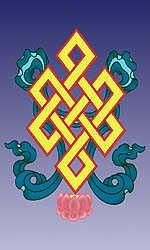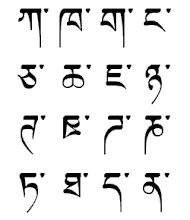
The Patra symbolizes perfection, fullness and the glory of the five wisdoms. It is sometimes referred to as the "knot of eternity", and is associated with the concept of tendrel, meaning
"interdependence". This is one of the fundamental notions of Buddhism in general, insofar as all phenomena are regarded as being interdependent and linked to causes and conditions.
(The Manual of Standard Tibetan, Nicolas Tournadre and Sangda Dorje).
The reason I placed this symbol here is because you cannot walk anywhere in McLeod Ganj without seeing this symbol. It is seen in most window frames of homes, offices, classrooms, restaurants, and temples. In my own apartment, there are about 12 of these knots all across my window. In many of the speeches given by the H.H. the Dalai Lama, almost always it will come down to interdependence. With everything connected, if you harm one thing you harm yourself. As I have been here I have been unable to study Buddhism directly due to my responsibilities at Tibet Charity, but I have made visual observations. When I first arrived here I noticed that many individual families will have rituals performed in there homes. The sounds of cymbals, drums and prayers can heard daily as one walks around. When I was staying with Dolma, every mornig I would hear her reciting prayers to the bronze deities that she had in a altar, to a picture of H.H. the Dalai Lama, and a thangka (really nice religious wall hanging of a deity or lama) of the medicine Buddha. I spoke to her one day about it, and she told me that her prayers are for the sustenance of Buddhism. She does this by taking refuge in the Buddha, refuge in his teachings, refuge in the Sangha (community of practitioners), and the Lama ( the one to transmit the teachings to the laity). This is what she repeats every morning. Walking around you will also notice a stupa that has many prayer wheels in a row built into the wall. People circumambulate this stupa in a clockwise direction turning the prayer wheels as the move along. Another object of circumambulation is the main temple, the Tsuklhakhang, in which there is a long route and a short route. These are usually called Kora, with Lingkor being the long route. Personal prayer wheels are seen handy, and the people twirl them with such finesse that the hand barely seemed to move, rosaries are also very common. It is normal to hear people saying under their breath Om Mani Padme Hung, the main mantra of Chenrezig (Bodhisattva) who Tibetans believe H.H. the Dalai Lama to be a manifestation of. Reciting this mantra, it is thought that one accumulate merit. One top of roofs of some houses small mini stupas or chortens are seen, except that they are hollow on the inside and a aromatic shrub is burned within it. It looks pretty nice when one of these hollow chortens are bellowing with smoke combined with the sounds of prayers. For the most part, I have seen mostly the elderly with prayer wheels, going on the kora, and reciting mantras. But I have also noticed young people are interested in Buddhism, it is their source of identity as Tibetans growing up in exile. Many are interested in things western, hip hop, technology, etc. I was talking with a student who had been studying the treatise of emptiness from Nagarjuna. I could tell that he was very serious about his studies. Though he was not a monk, he felt that is was important for him to study Buddhism. You do you see more than plenty young monks and nuns milling about. One lady named Yangzom in conversation class told me that since she had three boys, her and her husband enrolled one in a monastery. It is custom that if you have a few children at you enroll atleast one in a monastery. This morning I met a young monk named Kunga Gyaltso. He gave me a tour of the temples of Tsuklhakhang. He first took the Kalachakra Temple, where on the one of the wall was a huge painting of the Kalachakra mandala. Kalachakra is Sanskrit for the wheel of time, it represents the mind, body, consciousness. The mandala serve as a huge mansion with various different deities housing in the many rooms. They reside in very specific rooms, according to the aspect of the deity. Some deities are mind deities, some are body deities. Kalachakra is also a deity that resides in the center of the mandala. The mandala is then protected by a vajra or dorje band (the lighting wisdom that comes from tantric practice), and band of Tibetanized Sanskrit letters in the color of its deity, and by a band of wind. This mandala is absolutely huge. Outside the mandala then there are many deities and lamas.The lamas shows the lineages of the four main schools of Tibetan Buddhism, Nyingma, Kagyud, Sakya, Geluk. All of the lineages start with Indian Buddhist Masters from antiquity. At the Center wall there a huge painting of Shakyamuni Buddha, painted by Kelsang. I met Kelsang's brother Palden Oshoe in Ithaca, NY. I saw a 3ft Shakyamuni Buddha statue that Kelsang had made at Palden's house. Another one that he made is in the Smithsonian museum. He is a reknown painter and a sculptor. The front of the temple, there is also a overdose of painting. On each side of the Buddha are smaller mandalas that show the residents of the Kalachakra deities in detail. There are six small mandala's on each side of the Buddha, each symbolizing a character of the Tibetan zodiac. Tibetan astrologers use the Kalachakra text for astology. In front of all this are two jars with butter candles in them. On top them, suspended by a wire are round paper prayers wheel that turn my themselves due to the rising heat from the candles. There is one more huge mandala, the Mind mandala, because all the deities that it houses are mind deities. Ones' personal Lama guides the practitioners as to which deity will lead them to enlightment. Eventhough there are many deities you only need one, that one is called your Yidam, your deity that you will focus on the emptiness of. Kunga said that are many texts that describes all the many aspects of the individual deities. When you read these texts and visualize the deity, you eventually start to have the aspects of the deity. As you progress and see the emptiness of the deity the practitioner will know the deity like his/her ownself. The seat of H.H. Dalai Lama is covered up, with many Katak's draped on them. People place their foreheads on it. In January in Andhra Pardesh, at the stupa of Amaravati H.H the Dalai Lama will give a Kalachakra empowerment. This is a huge event and I hope that I get the oppertunty to attend. In the next temple there three statues, one of the Buddha in the center, Guru Rinpoche Padmasambhava, and the Thousand arm manifestation of Chenrezig on the side. Parts of the Chenrezig statue was smuggled out of Tibet during the Great Proletarian Cultural Revolution. This temple also houses the Kanjur and the Tenjur the main corpus of Tibetan Buddhist scriptures, which is over two thousand volumes long. Right next to this temple is a room with windows on all sides. Inside this room, are various tables with butter lamps, some lit and others unlit. Kunga told me that the public will come here to burn these lamps, some times they burn it for the safe travel for a deceased family member so that they have a good rebirth. It is a visual site, for these lamps are pretty small and there are so many of them. With them all lit it is a nice site. I was very appreciative of Kunga showing me around the temple and explaining things to me. All this religious activity that is incessant here, it is hard for it not to rub off of you. In the US, religion does not take on this quality of style. Most of the time, from my perspective it seems that religion is restricted only to setting and only used when one so feel like it. Of course there are exceptions to my perspective. But one thing is for sure, its the heighten religious activity here, the actions of the people reflect their religious lives. A big difference from back home. Eventhough home is mostly Christian and in McLeod Ganj there are alot of Buddhist, to me that is not so important. What I am looking at is the amount of time spend of out ones day that is devoted to religious activities. By sheer amount, religion is a live indentity, that you can touch, smell, see, and feel. Enough of my rantings.
Pax.

No comments:
Post a Comment